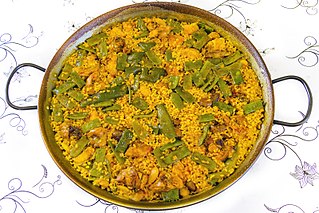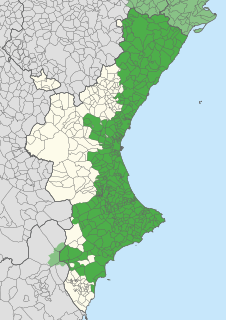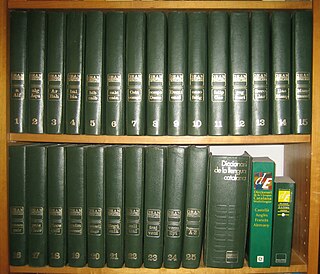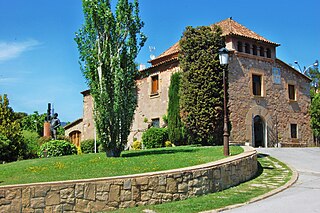
Catalan, known in the Valencian Community and Carche as Valencian, is a Western Romance language derived from Vulgar Latin. It is the only official language of Andorra, and a co-official language of three autonomous communities in eastern Spain: Catalonia, the aforementioned Valencian Community and the Balearic Islands. It also has semi-official status in the Italian comune of Alghero. It is also spoken in the Pyrénées-Orientales department of France and in two further areas in eastern Spain: the eastern strip of Aragon and the aforementioned Carche in the Region of Murcia. The Catalan/Valencian-speaking territories are often called the Països Catalans or "Catalan Countries".

Paella is a Spanish rice dish originally from Valencia.

Pa amb tomàquet, or Pan con tomate, is a traditional food of Catalan, Valencian, Aragonese, Balearic and Murcian cuisines in Spain. Pa amb tomàquet is considered a staple of Catalan cuisine and identity. It is a traditional national dish of Spain.

Catalan cuisine is the cuisine from Catalonia. It may also refer to the shared cuisine of Roussillon and Andorra, the second of which has a similar cuisine to that of the neighbouring Alt Urgell and Cerdanya comarques and which is often referred to as "Catalan mountain cuisine". It is considered a part of western Mediterranean cuisine.

Sausages are a meat product usually made from ground meat, often pork, beef, or poultry, along with salt, spices and other flavourings. Other ingredients such as grains or breadcrumbs may be included as fillers or extenders. Some sausages include other ingredients for flavour.

Benabarre, in Ribagorçan and Aragonese: Benavarri is a town and municipality in the Aragonese comarca of Ribagorza, in the province of Huesca, Spain.

Valencian or Valencian language is the official, historical and traditional name used in the Valencian Community (Spain), and extra-officially in the El Carche comarca in Murcia (Spain), to refer to the Romance language also known as Catalan. The Valencian Community's 1982 Statute of Autonomy and the Spanish Constitution officially recognise Valencian as the regional language.

Catalan grammar, the morphology and syntax of the Catalan language, is similar to the grammar of most other Romance languages. Catalan is a relatively synthetic, fusional language.
The phonology of Catalan, a Romance language, has a certain degree of dialectal variation. Although there are two standard dialects, one based on Eastern Catalan and one based on Valencian, this article deals with features of all or most dialects, as well as regional pronunciation differences. Various studies have focused on different Catalan varieties; for example, Wheeler (1979) and Mascaró (1976) analyze Central Eastern varieties, the former focusing on the educated speech of Barcelona and the latter focusing more on the vernacular of Barcelona, and Recasens (1986) does a careful phonetic study of Central Eastern Catalan.

Syndic is a term applied in certain countries to an officer of government with varying powers, and secondly to a representative or delegate of a university, institution or other corporation, entrusted with special functions or powers.

Valencian cuisine is a Mediterranean cuisine as cooked in the Valencian Community, Spain. Its basic ingredients are vegetables, seafood and meat. It is famous worldwide for its rices, such as paella, and its citrus fruits. The cuisine of neighbouring regions have given and received important contributions from Valencian gastronomy, amongst them Balearic cuisine, Catalan cuisine, Aragonese cuisine, Manchego cuisine and Murcian cuisine.

The Gran Enciclopèdia Catalana is a Catalan-language encyclopedia, started in fascicles, and published in 1968 by Edicions 62. The soul of the work was written by Max Cahner, and the first director was Jordi Carbonell. From the second volume the work had its own publisher: Enciclopedia Catalana SA with Jordi Pujol, and the new director was Joan Carreras i Martí.

Picada is one of the characteristic sauces and culinary techniques essential to Spanish cuisine. The technique is typically found in the Spanish region of Catalonia and Valencia and subsequently Catalan cuisine and Valencian cuisine. It is not an autonomous sauce like mayonnaise or romesco, but it is added as a seasoning during the cooking of a recipe.

A masia is a type of rural construction common to all the old Crown of Aragon: Catalonia, Valencian Community, Aragon, Languedoc and Provence. The estate in which the masia is located is called a mas. They are often large but isolated structures, nearly always associated with a family farming or livestock operation.

The dialects of the Catalan language feature a relative uniformity, especially when compared to other Romance languages; both in terms of vocabulary, semantics, syntax, morphology, and phonology. Mutual intelligibility between its dialects is very high, estimates ranging from 90% to 95%. The only exception is the isolated idiosyncratic Alguerese dialect.

Joan Francesc Mira i Casterà is a Valencian writer, anthropologist and sociologist. He is an honorary member of the Associació d'Escriptors en Llengua Catalana and President of Acció Cultural del País Valencià. In politics he is a supporter and has been a candidate of Valencian Nationalist Bloc in 2000 and 2003.

Bernat Fenollar, also Mossèn Fenollar was a poet, cleric and chess player from Valencia, Spain. He was an abbot, had a position both in Valencia Cathedral and the University of Valencia as a professor of mathematics.

The Nationalist Party of the Valencian Country was a political party created in 1978 by ex-members of the Democratic Union of the Valencian Country. In 1984 the party merged with the Left Grouping of the Valencian Country to form the Valencian People's Union.

The Carraixet ravine is a course of water from the north of the Valencian province, in the Valencian Community (Spain). It begins in Gátova and collects waters from the sloped southern side of the Calderona mountain range. It flows into the Mediterranean Sea through the town of Alboraya. At its mouth, it is also called the Olocau ravine or the Peralvillo ravine. In the Book of the Facts James I named it riu Sec, while discussing the Battle of the Puig.

Paelya or paella (Spanish), is a Philippine rice dish adapted from the Valencian paella. However, it differs significantly in its use of native glutinous rice (malagkit), giving it a soft and sticky texture, unlike the al dente texture favored in original paella. It is also characteristically topped with sliced eggs. Filipino paelya also does not use saffron, but instead use achuete (anatto), luyang dilaw, (turmeric), or kasubha (safflower).



















